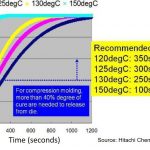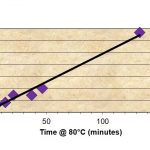Guest Post by Dr. R. Bruce Prime and Dr. John Avila This post outlines the mathematical approaches to model the cure behavior and then analyze the cure data to extract kinetic parameters. We do this by utilizing equations developed in the previous post that model the cure path of autocatalytic systems like epoxy-amine. Modeling Cure Behavior For this case we developed ... [Click to Continue...]
Thermoset Cure Kinetics Part 10: Autocatalytic Equations
Guest Post by Dr. R. Bruce Prime and Dr. John Avila This post describes the kinetic equations used to characterize thermoset reactions that are autocatalytic in nature. The autocatalytic equations originate from a kinetic equation based on the chemistry of the epoxy-amine reaction and invoke assumptions that simplify the math. Epoxy-amine thermosets are in widespread use ... [Click to Continue...]
Thermoset Cure Kinetics; Guest Post Series
On Monday we provided a review of cure kinetics (Part 9) and set the stage for an exciting series on Thermoset Cure Kinetics by Dr. R. Bruce Prime and Dr. John Avila. Over the next six weeks, the following guest posts will be presented: Thermoset Cure Kinetics Part 10: Autocatalytic Equations Thermoset Cure Kinetics Part 11: A Mathematical Approach to Kinetics ... [Click to Continue...]
Thermoset Cure Kinetics Part 9: Review of Thermoset Cure Kinetics
Guest Post by Dr. R. Bruce Prime and Dr. John Avila Like cooking, thermoset curing is a time-temperature process. Kinetics addresses relationships between time and temperature. For the next seven weeks we continue the series of 8 blogs on Thermoset Cure Kinetics posted in October, November and December 2014. The previous series covered the basic concepts of kinetics, ... [Click to Continue...]
Happy Labor Day
Wishing all my loyal readers a safe and relaxing Labor Day weekend. I am excited to announce that next week, Dr. Bruce Prime will be back with an extensive series of guest posts on Kinetics of Thermosetting Polymers. Dr. Prime is a former IBM colleague and Principal Consultant at InnoCentrix. Bruce and I have collaborated on several projects including our comprehensive book ... [Click to Continue...]


